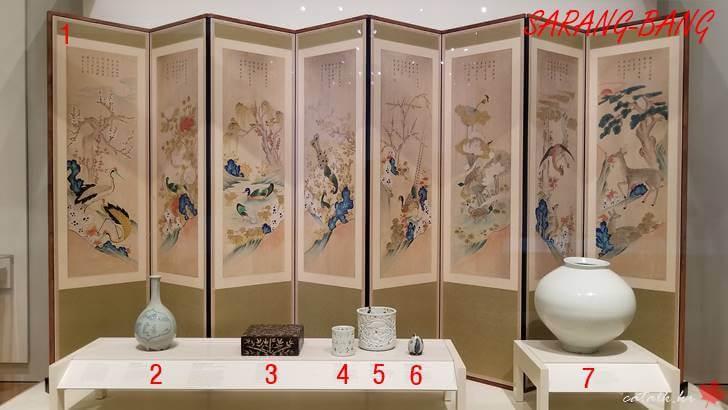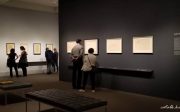Korean traditional man’s room, Sarangbang
Sarangbang
Sarangbang is a room located in a Korean traditional house (hanok) which served as man’s room, used for studying, writing poetry, and leisure activities. The objects described below would all have featured in a sarangbang. This was the focal room in a traditional Korean house, where an aristocrat would read, write, and entertain his male guests while being served by women. The room was usually furnished modestly with a few wooden bookshelves and a low desk to hold books and writing essentials. Inhabitants would sit on cushions on the paper-covered floor with an under-floor heating system called ondol, surrounded by a few screens and scroll paintings.

Museum of Fine Arts, Boston
1. Screen with flowers and birds
- Joseon dynasty, late 19th century
- Eight-panel folding screen; ink and color on paper with silk brocade mounting
- So-called “bird-and-flower” paintings featured a bird or birds with a flowering tree of the artist’s choice. Later, the theme broadened to encompass all varieties of auspiciously symbolic flora and fauna and was popular with many painters, including those employed at the court to serve the demand of the royal household. These well-trained and -practiced court painters were able to create more elaborate paint- ings in brilliant colors. This fine example depicts the Ten Symbols of Longevity-sun, mountain, water, rock, pine, cloud, bulnocho (an imaginary plant symbolic of eternal life), tortoise, crane, and deer. They combine with other popular symbolic creatures and plants, such as a pair of mandarin ducks (happy marriage) and peony (wealth).
2. Octagonal bottle
- Joseon period, late 18th century
- White porcelain with underglaze cobalt-blue decoration
- This wine bottle would have probably been used by a scholarly gentleman. Such decoration-with figures in a landscape, confined in avindow in the shape of a Korean ivy leaf-appealed to the elite yangban class. This octagonal faceted shape was popular at the time. It may have been made at the official kiln near Seoul.
3. Document box
- Joseon dynasty, 17th-18th centuries
- Lacquer with mother of pearl
- This box would have been used for storing a scholar’s papers or stationery. The lid’s bird and-flower scene is reminiscent of literati-style painting plum blossoms and bamboo were two popular motifs with scholarly connotations. The entire scene is inlaid using large and thick slices of mother-of-pearl scored to produce a crackled look.
4. Brush holder
- Joseon dynasty, 19th century
- White porcelain
- A gentleman’s study would contain everything needed for writing from paper and writing brushes to cakes of solid ink, ink stones, and more. Judging from its overall translucent and bluish glaze. this brush holder was probably made in an official kin. Its distinctive geometric designs resemble woodwork Openwork lke this was a recurring decorative feature of Korean ceramics.
5. Paper holder
- Joseon dynasty, 19th century
- White porcelain
- Used to hold either large writing brushes or rolls of paper, this container’s intricate openwork decoration features auspicious symbols-dragons, tortoises, lions-surrounded by clouds and scrolls.
6. Peach-shaped water dropper
- Joseon dynasty, 19th century
- White porcelain with underglaze cobalt-blue and iron-brown
- Made in the form of a ripe peach, this water dropper (used to add water to dry ink) highlights Korean inventive playfulness.With their connotations of health and longevity (and their covert sexual innuendo) peaches were a new shape for water droppers in the late joseon period.Other novel forms included carp persimmons, toads, ions, houses, and mountains.
7. Moon jar
- Joseon dynasty, early 18th century
- White porcelain
- Ths bulbous storage jar in the shape of a full moor with its imperfect symmetry and generous, full volume, epitomizes the austere Confucian aesthetic of the joseon dynasty. Its simplicity refiects the Korean love of natural forms. Typically fired in two parts (upper and lower) and luted together to form a complete work, moon jars were popular in Japan and amongst early 20th-centiry Folk Craft scholars, who appreciated their asymmetry.



